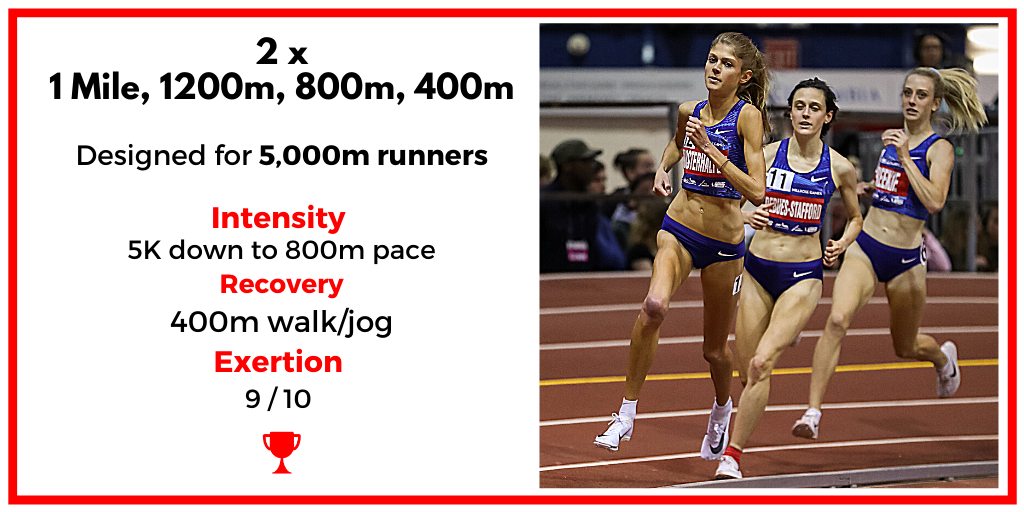Workout of the Day: 2 x (1 Mile, 1200m, 800m, 400m)
2 x (1 Mile, 1200m, 800m, 400m)
Intensity — 5K pace on 1M, 3K pace on 1200m, 1500m on 800m, 800m or faster pace on 400m
Recovery — 400m jog after each rep and between sets
Exertion — 9/10
Context & Details
Only races should be 10/10 exertion since there are no recovery periods, but this is perhaps the most difficult workout I have written about.
This was one of Salazar's go-to workouts. I've seen so many Oregon Project runners of the 2010s era do this session: Galen Rupp, Kara Goucher, Jordan Hasay, Mo Farah, etc. I once witnessed Galen do this workout with the 1 Mile reps at 4:01 and 3:59, then cut down to 55" - 54" for the 400m. All on 400m jog recovery.
The best running workouts are hard. If a workout is "easy" it's not really a workout but a maintenance session. Workouts don't build you up — they tear you down. Many novices think you get better during a workout, not so, your state of being actual gets worse in the short term. It's the quality of the subsequent restorative period, which determines how much you improve. Remember, Stress + Rest = Growth.
My runners do tough workouts. But then they take very generous recovery days. When I coached Tara Welling, her workouts would be very tough, but her recovery runs were no faster than 8:00/mile pace. She was top 10 at the 2016 US Olympic Trials and recorded PRs that season of 15:26 and 32:00 on the track — before the advent of super-foam, magic shoes.
There are universal truths to training, stress, recovery, and adaptation we must remember.
Training is the process whereby the body is systemically exposed to a given set of stressors to enable it to manage future exposures to those stressors more efficiently.
The general adaptation syndrome (GAS), developed by Hans Selye, describes the pattern of responses that the body goes through after being prompted by a stressor. There are three stages: alarm, resistance, and exhaustion.
Alarm – This occurs when we first perceive something as stressful, and then the body initiates the fight-or-flight response. In a workout, the athlete's body is in "fight" mode.
Resistance – If the perceived stress continues, the body stays activated at a higher metabolic level in an effort to offset the persistent stress. The body cannot maintain this level indefinitely, and its resources will eventually deplete. This is why volume, pace, and density load and rest intervals within a workout are so important when constructing workouts. Each variable needs to be tailored to be athlete appropriate for a session to be effective.
Exhaustion – Prolonged exposure to the stressor will result in the depletion of the body's resources, and the resulting wear and tear will suppress the immune system and cause bodily functions to deteriorate. This is final end game of all effective workouts. Near, but not complete, exhaustion.
Now the body is exhausted, recovery and recuperation become paramount for the next 24 - 72 hours. Without deep and adequate recovery growth, or adaptation/super-compensation cannot happen. Skimping on the post-workout recuperation period will lead to under-recovery syndrome, overtraining syndrome, burnout, illness, and/or injury. It's a razor's edge.
Workouts are only as effective as the recovery period that compliments it. A session like this took Galen 3-4 days to recover from fully. For the less experienced or the chronically under recovered runner, it can take a week or more.
Aggressive cutdown sessions are really effective for elevating several key performance variables: vVO2 Max, race-specific lactate-threshold velocity, resistance to fatigue, running economy, neuromuscular power, and aerobic power — but only if the appropriate depth and breadth of recuperation is taken by the runner post-workout.

